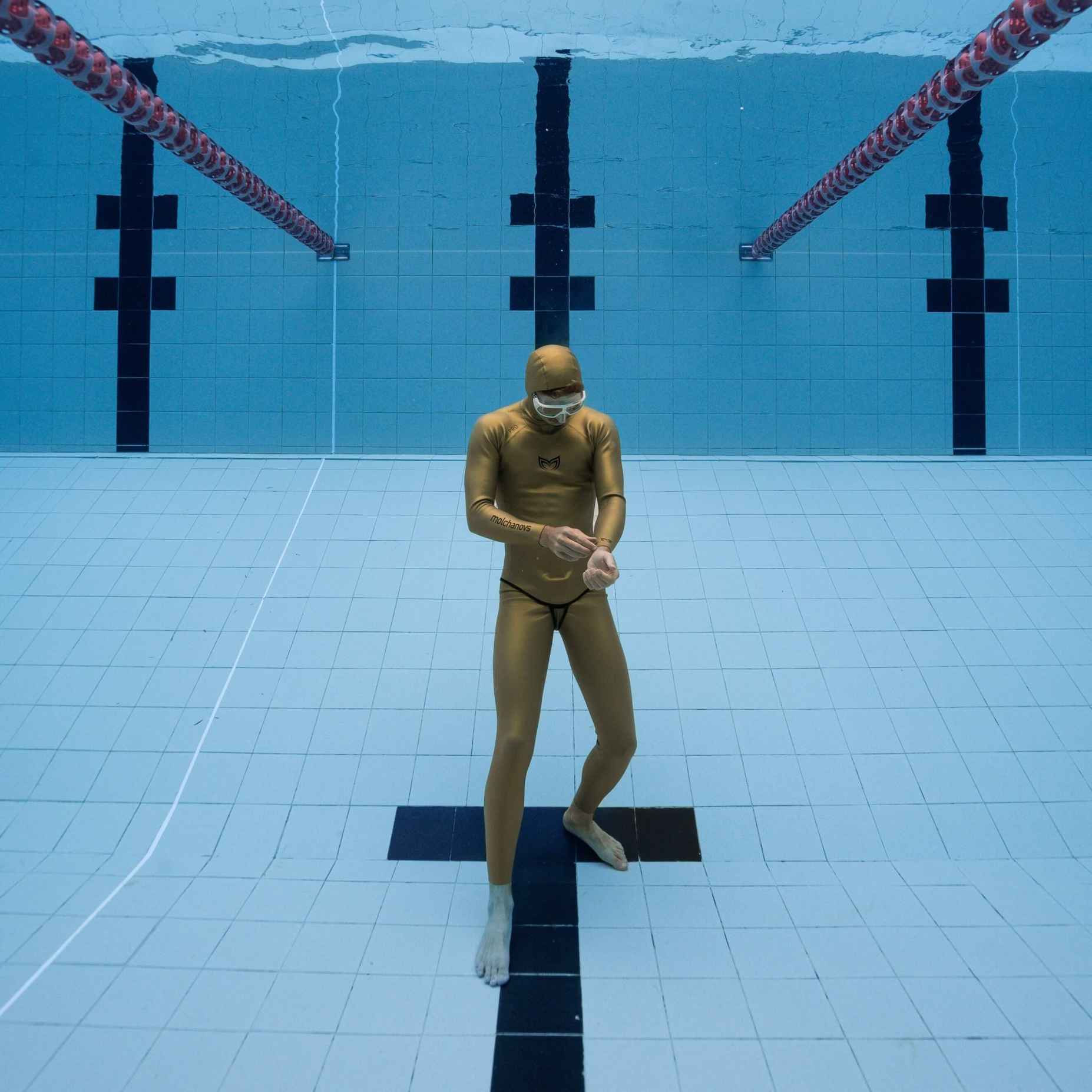Frenzel vs. Valsalva Equalization for Freediving

By Kristina Zvaritch
Equalization is one of the biggest barriers for beginners when it comes to going deeper in freediving. Even if you are already a scuba diver or avid snorkeler and have no problem equalizing while you dive, equalization for freediving is very different! One of the reasons for this difference is that freedivers must use the Frenzel maneuver to go deeper, while many scuba divers and snorkelers can get by on their dives using the Valsalva maneuver. But do you know the differences between Frenzel and Valsalva equalization?
While the Valsalva maneuver is easy to learn and involves just blowing against your pinched nose, it’s not recommended for freediving because it uses your breathing muscles and doesn’t work past certain depths. On the other hand, the Frenzel maneuver uses smaller muscle groups (non-breathing ones), is more controlled and relaxed, and will take you deeper! Learn more about equalization anatomy and terminology, a brief overview of Valsalva and Frenzel, and how to improve your Frenzel technique below.

Anatomy of the ear in equalization
Eustachian tube - The canal that connects your middle ear to the upper part of your throat and the back of your nasal cavity (nasopharynx).
Middle ear - The part of your ear between your eardrum and the oval window. It’s where ambient pressure increases and puts pressure on your eardrums, causing them to flex inward and the reason why you feel pressure or pain if you descend without equalizing properly. Equalization using the Valsalva maneuver
Equalization using the Valsalva maneuver
The Valsalva maneuver also goes against one of the most important things you need in freediving - relaxation! This means that you will use more energy and oxygen performing Valsalva than you would performing Frenzel. So even if you start your freediving journey with Valsalva, eventually you must switch to using Frenzel.

If you are not a Molchanovs Movement member and want to become one to get access to Frenzel Fundamentals, other Base Training programs, discounts on Base Training + programs, and all the other perks that come with membership, you can book a Base Training Induction Online (BTIO) Assessment to become a Movement member and upgrade your freediving experience!
SCHEDULE YOUR BTIO ASSESSMENT
Remember that freediving is a physical activity that requires training and effort to improve and keep safe - it isn’t just something ‘natural’ that you were born knowing how to do. With hard work, passion, and dedication, you can overcome any obstacle you encounter on your journey to become a better (and safer) freediver. And we’re here to help you do just that!
Equalization is one of the biggest barriers for beginners when it comes to going deeper in freediving. Even if you are already a scuba diver or avid snorkeler and have no problem equalizing while you dive, equalization for freediving is very different! One of the reasons for this difference is that freedivers must use the Frenzel maneuver to go deeper, while many scuba divers and snorkelers can get by on their dives using the Valsalva maneuver. But do you know the differences between Frenzel and Valsalva equalization?
While the Valsalva maneuver is easy to learn and involves just blowing against your pinched nose, it’s not recommended for freediving because it uses your breathing muscles and doesn’t work past certain depths. On the other hand, the Frenzel maneuver uses smaller muscle groups (non-breathing ones), is more controlled and relaxed, and will take you deeper! Learn more about equalization anatomy and terminology, a brief overview of Valsalva and Frenzel, and how to improve your Frenzel technique below.
The Anatomy of Equalization

Anatomy of equalization
Nasopharynx - The upper part of your throat that connects to your nasal cavity. Located above the soft palate.
Soft palate - Directs the flow of air in and out of your lungs to either your nose, mouth, or both at the same time.
Vocal folds / Glottis - This is a group of muscles that separate your mouth from your lungs. When you hold your breath, your vocal folds are closed.
Larynx / Voice Box - This tube sits above the trachea and in front of the esophagus, controlling the flow of air.
Epiglottis - A flap of cartilage at the top of the larynx near the base of the tongue. Prevents food from entering your larynx.

Eustachian tube - The canal that connects your middle ear to the upper part of your throat and the back of your nasal cavity (nasopharynx).
Middle ear - The part of your ear between your eardrum and the oval window. It’s where ambient pressure increases and puts pressure on your eardrums, causing them to flex inward and the reason why you feel pressure or pain if you descend without equalizing properly.
Overview: Valsalva Maneuver
 Equalization using the Valsalva maneuver
Equalization using the Valsalva maneuver The Valsalva maneuver is very easy to learn, which is why it’s commonly used by scuba divers, snorkelers, and beginner freedivers. All you do is close your mouth, pinch your nose, and exhale against your pinched nose. That air gets pushed through your Eustachian tubes and into your middle ear, which returns your eardrums that have flexed inward due to pressure back to their normal position.
Why isn’t Valsalva recommended for freediving?
While the Valsalva maneuver is easy and quick to learn, it’s not recommended for freediving because you must use your breathing muscles to push the air from your lungs. This can work with the constant lungfuls of air a scuba diver gets from a tank, along with being in a mostly-horizontal position. However, freedivers’ lungs compress at depth, and they also dive vertically, which makes it harder for their breathing muscles to push up air from compressed lungs. At deeper depths, freedivers who continue trying to perform Valsalva are also at more risk of injury, both to their lungs and possibly to their ears due to the forcefulness of Valsalva.The Valsalva maneuver also goes against one of the most important things you need in freediving - relaxation! This means that you will use more energy and oxygen performing Valsalva than you would performing Frenzel. So even if you start your freediving journey with Valsalva, eventually you must switch to using Frenzel.
Overview: Frenzel Maneuver

Equalization using the Frenzel maneuver
The Frenzel maneuver can be harder to learn because it involves a lot of muscle awareness and control (although some people are just able to do it automatically - no one knows why!). It involves pinching your nostrils and placing your tongue in a certain position to make the “T” or “K” sound. While doing this, you close your vocal folds and and lift your larynx up to push the air out of your mouth and into your nose (your soft palate needs to be in a neutral position). You should not have any belly movement while performing this technique. While you may be able to perform Frenzel on land, it’s often a little more complicated in the water due to being in a head-first position and being in an unfamiliar environment (and on a breath-hold!).Why Frenzel is recommended for freediving
The Frenzel maneuver is the preferred method for freediving simply because smaller muscle groups are needed to perform the technique, no breathing muscles are required to push the air up from your lungs, and it’s much more controlled and relaxing - in other words, it’s perfect for freediving! Proper Frenzel technique can take you to depths of 30 - 40m (98 - 131ft), and even beyond with plenty of training. While some freedivers may naturally use Frenzel to equalize or learn it fairly quickly, if you are someone who is having trouble learning it - you are definitely not alone! Plenty of freedivers have spent days or weeks in achieving proper Frenzel technique. Adam Stern, multiple Australian National Record Holder and Molchanovs Founding Team Member, even made a wildly popular step-by-step tutorial on how to learn Frenzel equalization, helping a countless number of freedivers learn this specific technique.How to Learn (or Improve) your Frenzel Equalization
We know how hard it can be to learn and perfect Frenzel equalization. That’s why Molchanovs equalization guru Adam Stern created a Base Training program for Molchanovs Movement members called Frenzel Fundamentals. Perfect for beginners who struggle with Frenzel equalization skills and freedivers who want more control of their muscles, Freediving Fundamentals is a 3-week program that is ideally performed before your first freediving course. Adam explains the individual skills in a video and gives you the order and number of reps you need to perform them in three different workouts per week. Consistent practice is key, and Frenzel Fundamentals provides you with the tools you need for Frenzel success! Some of Adam’s exercises require an EQ Trainer (a tool for training Frenzel and mouthfill equalization and reverse packing technique) for the full experience, although there are exercises you can perform without the EQ Trainer.Get Access to Frenzel Fundamentals by Adam Stern
Molchanovs Movement members with access to Base Training get automatic access to the program here. If you are about to take a Molchanovs Lap/Wave freediving course and have already registered, you can ask your Molchanovs instructor to already give you access to your 3 free months of Base Training so you can practice your Frenzel skills before the start of the course.If you are not a Molchanovs Movement member and want to become one to get access to Frenzel Fundamentals, other Base Training programs, discounts on Base Training + programs, and all the other perks that come with membership, you can book a Base Training Induction Online (BTIO) Assessment to become a Movement member and upgrade your freediving experience!
Remember that freediving is a physical activity that requires training and effort to improve and keep safe - it isn’t just something ‘natural’ that you were born knowing how to do. With hard work, passion, and dedication, you can overcome any obstacle you encounter on your journey to become a better (and safer) freediver. And we’re here to help you do just that!





Leave a comment